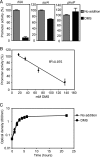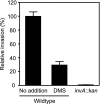Inhibition of Salmonella host cell invasion by dimethyl sulfide
- PMID: 20562287
- PMCID: PMC2916459
- DOI: 10.1128/AEM.00851-10
Inhibition of Salmonella host cell invasion by dimethyl sulfide
Abstract
We show that dimethyl sulfoxide (DMSO) inhibits Salmonella hilA expression and that this inhibition is stronger under anaerobiosis. Because DMSO can be reduced to dimethyl sulfide (DMS) during anaerobic growth, we hypothesized that DMS was responsible for hilA inhibition. Indeed, DMS strongly inhibited the expression of hilA and multiple Salmonella pathogenicity island 1 (SPI-1)-associated genes as well as the invasion of cultured epithelial cells. Because DMSO and DMS are widespread in nature, we hypothesize that this phenomenon may contribute to environmental sensing by Salmonella.
Figures





Similar articles
-
Lon protease activity causes down-regulation of Salmonella pathogenicity island 1 invasion gene expression after infection of epithelial cells.Infect Immun. 2004 Apr;72(4):2002-13. doi: 10.1128/IAI.72.4.2002-2013.2004. Infect Immun. 2004. PMID: 15039320 Free PMC article.
-
hilA is a novel ompR/toxR family member that activates the expression of Salmonella typhimurium invasion genes.Mol Microbiol. 1995 Nov;18(4):715-27. doi: 10.1111/j.1365-2958.1995.mmi_18040715.x. Mol Microbiol. 1995. PMID: 8817493
-
Differences in Host Cell Invasion and Salmonella Pathogenicity Island 1 Expression between Salmonella enterica Serovar Paratyphi A and Nontyphoidal S. Typhimurium.Infect Immun. 2016 Mar 24;84(4):1150-1165. doi: 10.1128/IAI.01461-15. Print 2016 Apr. Infect Immun. 2016. PMID: 26857569 Free PMC article.
-
Differential regulation of Salmonella typhimurium type III secreted proteins by pathogenicity island 1 (SPI-1)-encoded transcriptional activators InvF and hilA.Infect Immun. 1999 Aug;67(8):4099-105. doi: 10.1128/IAI.67.8.4099-4105.1999. Infect Immun. 1999. PMID: 10417179 Free PMC article.
-
The Small RNA PinT Contributes to PhoP-Mediated Regulation of the Salmonella Pathogenicity Island 1 Type III Secretion System in Salmonella enterica Serovar Typhimurium.J Bacteriol. 2019 Sep 6;201(19):e00312-19. doi: 10.1128/JB.00312-19. Print 2019 Oct 1. J Bacteriol. 2019. PMID: 31262841 Free PMC article.
Cited by
-
Nonredundant Dimethyl Sulfoxide Reductases Influence Salmonella enterica Serotype Typhimurium Anaerobic Growth and Virulence.Infect Immun. 2023 Feb 16;91(2):e0057822. doi: 10.1128/iai.00578-22. Epub 2023 Feb 1. Infect Immun. 2023. PMID: 36722978 Free PMC article.
-
Antibacterial Properties of Organosulfur Compounds of Garlic (Allium sativum).Front Microbiol. 2021 Jul 27;12:613077. doi: 10.3389/fmicb.2021.613077. eCollection 2021. Front Microbiol. 2021. PMID: 34394014 Free PMC article. Review.
-
Poultry body temperature contributes to invasion control through reduced expression of Salmonella pathogenicity island 1 genes in Salmonella enterica serovars Typhimurium and Enteritidis.Appl Environ Microbiol. 2015 Dec;81(23):8192-201. doi: 10.1128/AEM.02622-15. Epub 2015 Sep 18. Appl Environ Microbiol. 2015. PMID: 26386070 Free PMC article.
-
Integrating global regulatory input into the Salmonella pathogenicity island 1 type III secretion system.Genetics. 2012 Jan;190(1):79-90. doi: 10.1534/genetics.111.132779. Epub 2011 Oct 20. Genetics. 2012. PMID: 22021388 Free PMC article.
-
O2-dependent incapacitation of the Salmonella pathogenicity island 1 repressor HilE.Front Cell Infect Microbiol. 2025 Feb 18;15:1434254. doi: 10.3389/fcimb.2025.1434254. eCollection 2025. Front Cell Infect Microbiol. 2025. PMID: 40041146 Free PMC article.
References
-
- Bajaj, V., R. L. Lucas, C. Hwang, and C. A. Lee. 1996. Co-ordinate regulation of Salmonella typhimurium invasion genes by environmental and regulatory factors is mediated by control of hilA expression. Mol. Microbiol. 22:703-714. - PubMed
-
- Bentley, R., and T. G. Chasteen. 2004. Environmental VOSCs—formation and degradation of dimethyl sulfide, methanethiol and related materials. Chemosphere 55:291-317. - PubMed
-
- Charlson, R. J., J. E. Lovelock, M. O. Andreae, and S. G. Warren. 1987. Oceanic phytoplankton, atmospheric sulphur, cloud albedo and climate. Nature 326:655-661.
Publication types
MeSH terms
Substances
Grants and funding
LinkOut - more resources
Full Text Sources
Medical

